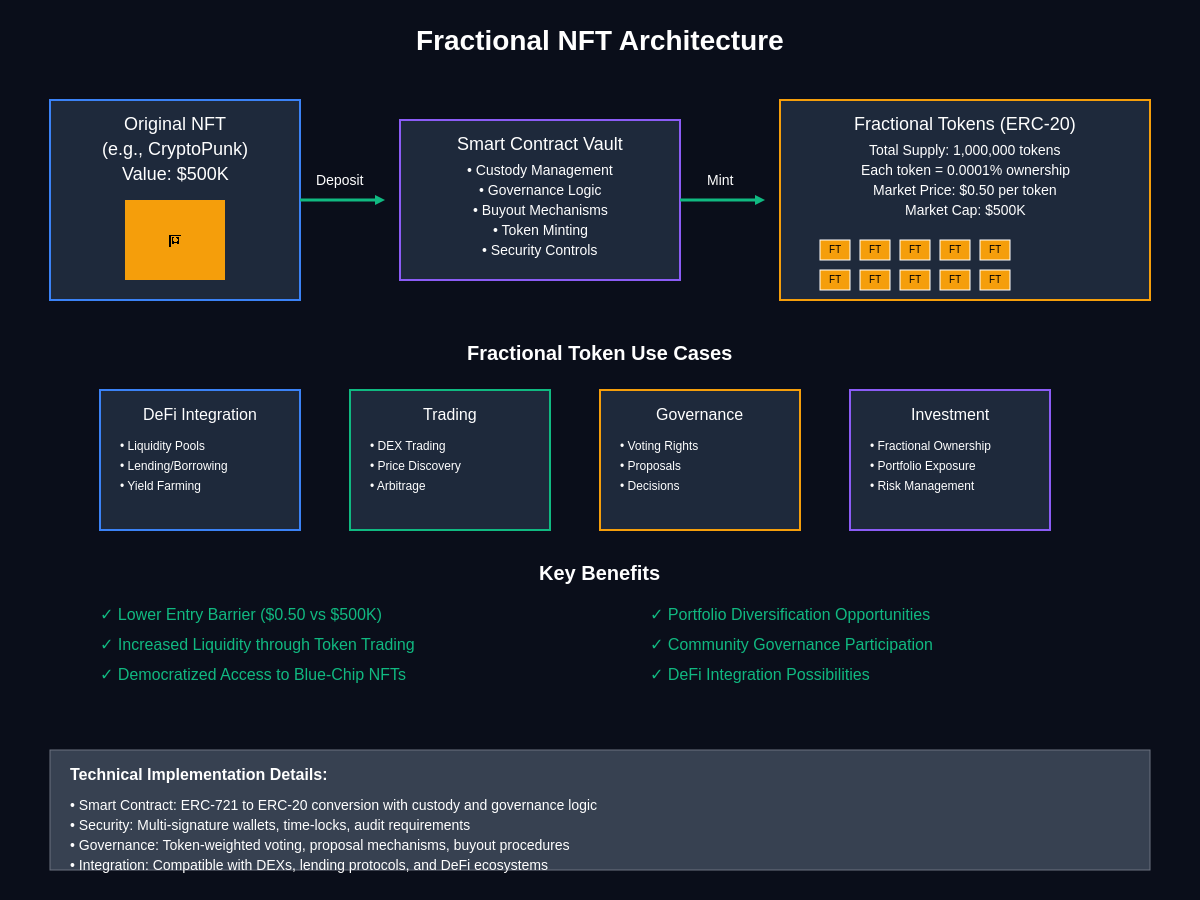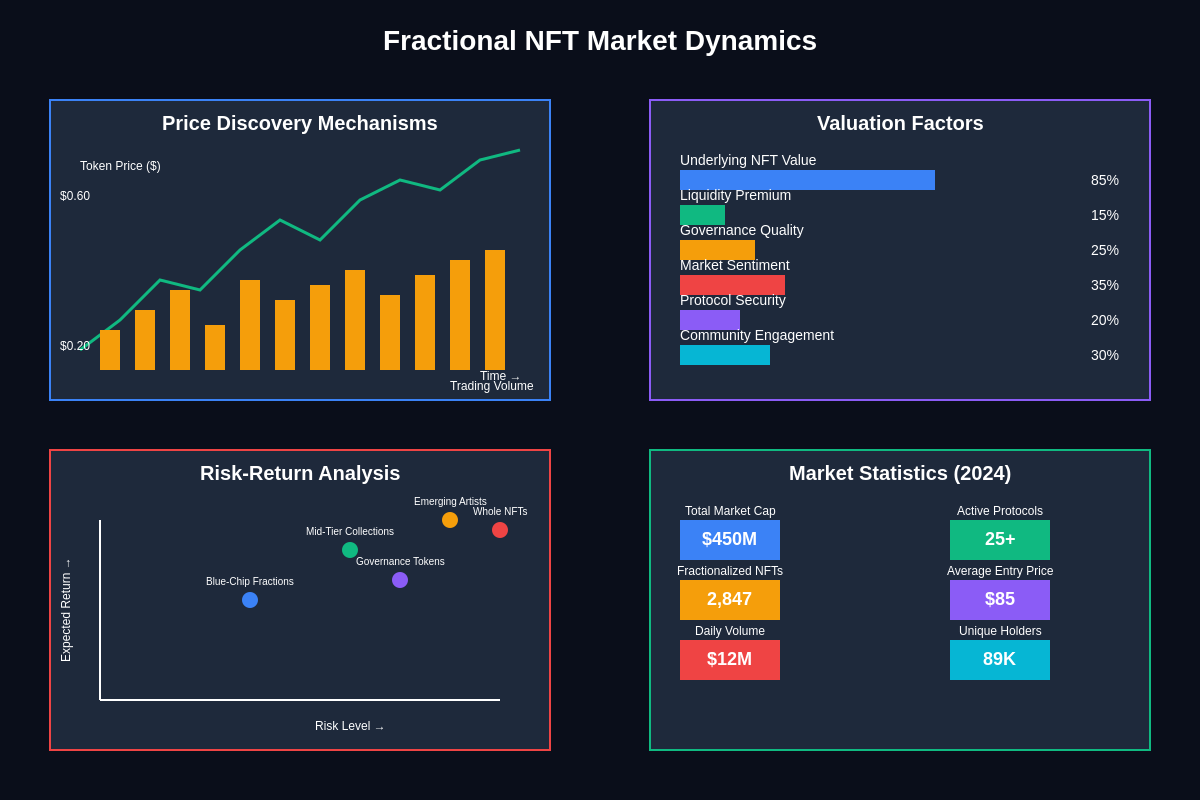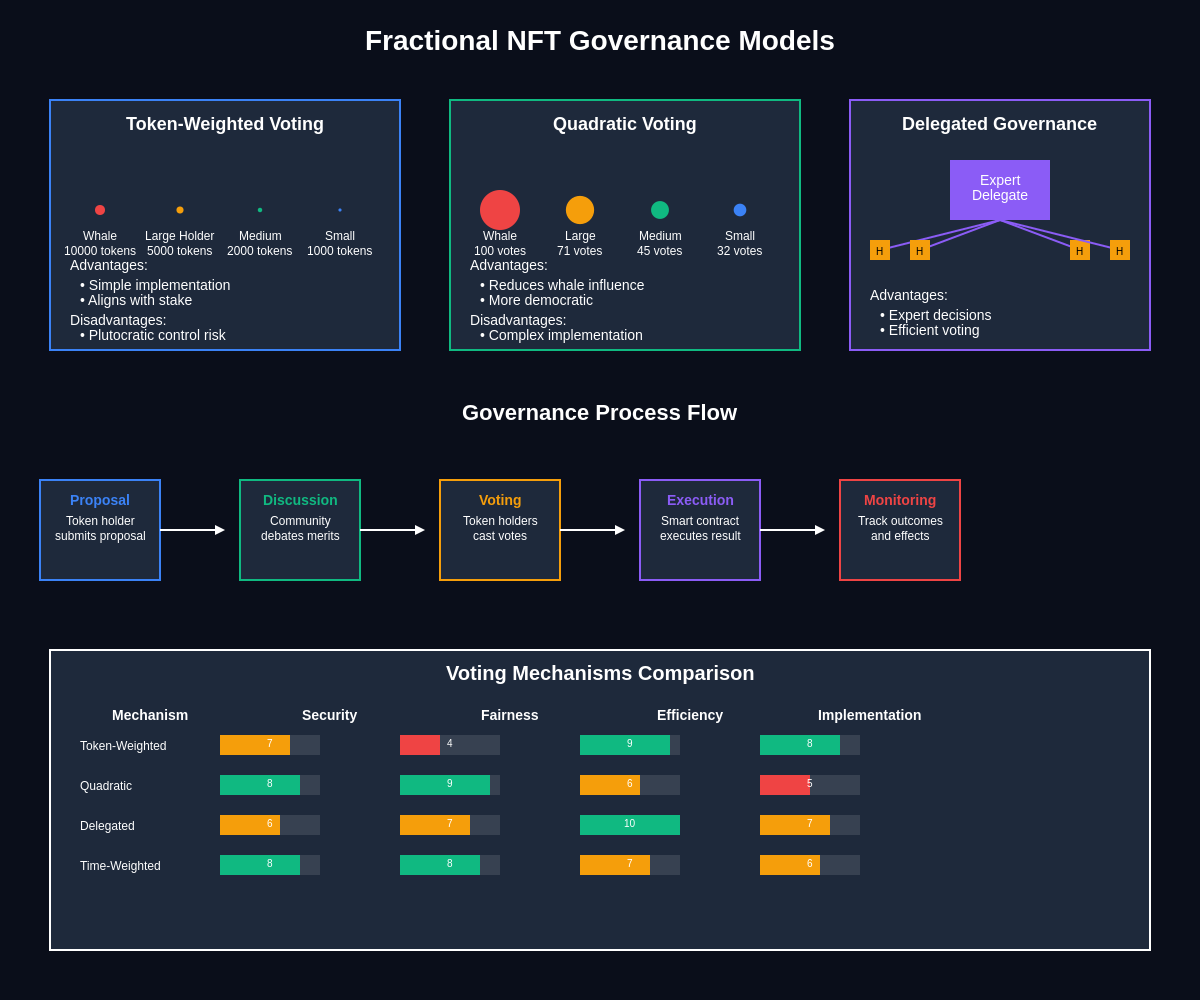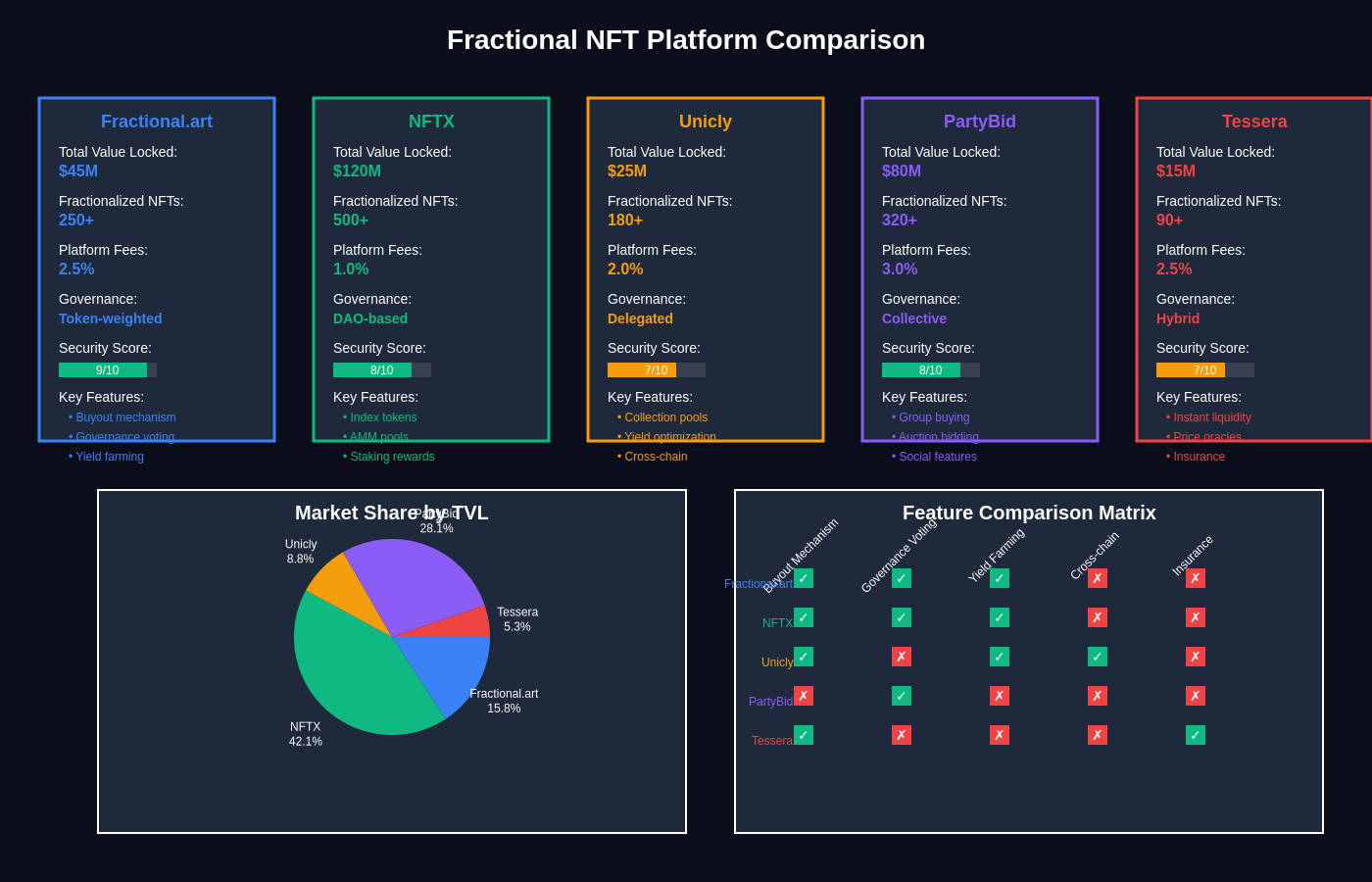Trade NFT collections and analyze market data with TradingView’s comprehensive analytics
The Revolution of Accessible Digital Ownership
Fractional Non-Fungible Tokens represent a paradigm shift in digital asset ownership, breaking down the financial barriers that have historically excluded smaller investors from participating in high-value NFT collections. This innovative approach to NFT ownership allows multiple investors to collectively own portions of expensive digital assets, transforming exclusive blue-chip collections into accessible investment opportunities for a broader audience. The emergence of fractional NFTs addresses one of the most significant challenges in the NFT market: the concentration of valuable assets among wealthy collectors who can afford to purchase entire pieces, often worth hundreds of thousands or even millions of dollars.
The concept of fractionalization has democratized access to premium NFT collections by enabling partial ownership through the creation of fungible tokens that represent fractional interests in the underlying NFT. This mechanism allows investors with smaller budgets to gain exposure to prestigious collections like CryptoPunks, Bored Ape Yacht Club, and Art Blocks, which were previously accessible only to high-net-worth individuals. The fractional ownership model has fundamentally changed the dynamics of NFT investment, creating new liquidity pools and enabling price discovery mechanisms that were impossible with traditional whole-NFT ownership structures.
Technical Architecture of NFT Fractionalization
The technical infrastructure underlying fractional NFTs relies on sophisticated smart contract systems that manage the relationship between the original NFT and its fractional representations. When an NFT is fractionalized, it is typically deposited into a smart contract vault that serves as the custodian for the underlying asset, while simultaneously minting a predetermined number of ERC-20 tokens that represent fractional ownership shares. These fractional tokens maintain a direct mathematical relationship to the underlying NFT, with each token representing a specific percentage of ownership rights in the original asset.

The smart contract architecture must address several critical technical challenges including custody security, governance mechanisms for collective decision-making, buyout procedures for reunifying fractional ownership, and integration with existing NFT marketplaces and DeFi protocols. Advanced fractionalization protocols implement multi-signature security schemes, time-locked governance functions, and sophisticated oracle systems to ensure accurate valuation and fair distribution of proceeds from potential sales or other monetization activities.
Interoperability considerations are paramount in fractional NFT systems, as these tokens must function seamlessly across various DeFi protocols, decentralized exchanges, and NFT marketplaces while maintaining their connection to the underlying digital asset. The technical implementation often involves complex proxy contract patterns, upgradeable contract architectures, and comprehensive event logging systems that enable transparent tracking of ownership changes and governance decisions.
Market Dynamics and Valuation Mechanisms
The valuation of fractional NFT tokens presents unique challenges that differ significantly from traditional whole-NFT pricing mechanisms, as fractional tokens must balance individual liquidity needs with collective asset value while accounting for governance premiums and potential reassembly scenarios. Market makers and automated market maker protocols have emerged to provide liquidity for fractional NFT tokens, enabling continuous trading and price discovery that reflects both the underlying NFT’s perceived value and the specific rights and restrictions associated with fractional ownership.
Analyze NFT market trends and fractional token performance using advanced charting tools
The relationship between fractional token prices and underlying NFT values is complex and often involves significant premiums or discounts based on factors including liquidity availability, governance structure quality, buyout mechanism design, and market sentiment toward the specific collection or individual asset. Academic research and market analysis have identified several pricing anomalies in fractional NFT markets, including situations where the aggregate value of fractional tokens exceeds reasonable estimates of the underlying NFT’s worth, and conversely, cases where fractional tokens trade at substantial discounts to implied NFT values.
Price discovery mechanisms for fractional NFTs incorporate traditional financial concepts like net asset value calculations, but must also account for the illiquid nature of the underlying assets, the costs associated with governance and custody, and the potential value destruction or creation that may result from collective ownership structures. Sophisticated investors and algorithrage participants actively monitor these pricing relationships, creating opportunities for arbitrage while contributing to more efficient price discovery across fractional NFT markets.

Governance Models and Collective Decision Making
Governance structures for fractional NFTs represent one of the most innovative aspects of this emerging asset class, as they must balance democratic participation from multiple stakeholders with the practical need for efficient decision-making regarding high-value digital assets. Most fractional NFT protocols implement token-weighted voting systems where fractional token holders can participate in decisions regarding the underlying NFT, including proposals for sale, licensing arrangements, display permissions, and other management decisions that affect the asset’s value or utility.
The complexity of collective governance becomes particularly apparent when fractional NFT holders must decide whether to accept buyout offers, pursue licensing opportunities, or make decisions about custody and storage of the underlying digital asset. Different protocols have experimented with various governance mechanisms including quadratic voting systems designed to prevent plutocratic control, time-weighted voting that rewards long-term holders, and delegated governance models that allow token holders to appoint specialized representatives to make technical decisions on their behalf.
Voting mechanisms must address several practical challenges including minimum participation thresholds to ensure legitimacy of governance decisions, dispute resolution procedures for contentious votes, and emergency governance protocols for situations requiring rapid response to protect asset value. The evolution of fractional NFT governance has drawn inspiration from traditional corporate governance, decentralized autonomous organization structures, and cooperative ownership models, resulting in hybrid systems that attempt to optimize for both efficiency and fairness.

Legal and Regulatory Considerations
The legal status of fractional NFTs exists in a complex regulatory environment where traditional securities laws, intellectual property rights, and emerging digital asset regulations intersect to create unprecedented compliance challenges for both protocol developers and investors. The fundamental question of whether fractional NFT tokens constitute securities under existing regulatory frameworks remains largely unresolved, with different jurisdictions taking varying approaches to classification and oversight of these innovative financial instruments.
Intellectual property considerations add another layer of complexity to fractional NFT ownership, as the rights associated with the underlying digital asset may not be perfectly divisible among fractional owners, potentially creating conflicts over commercial use, display rights, derivative work creation, and other intellectual property exploitation opportunities. Legal practitioners specializing in digital assets have identified numerous gray areas in existing intellectual property law that may require legislative clarification or judicial interpretation to provide clarity for fractional NFT participants.
Monitor regulatory developments and compliance requirements with comprehensive market analysis tools
Regulatory compliance requirements for fractional NFT protocols vary significantly across jurisdictions, with some regulators taking proactive approaches to provide guidance while others maintain wait-and-see positions that create uncertainty for market participants. The intersection of securities regulations, anti-money laundering requirements, tax obligations, and consumer protection laws creates a complex compliance matrix that fractional NFT protocols must navigate while maintaining innovation and accessibility for users.
Economic Impact on NFT Markets
The introduction of fractional ownership has fundamentally altered the economic dynamics of NFT markets by increasing liquidity, expanding the investor base, and creating new price discovery mechanisms that affect both fractional and whole NFT valuations. Fractional NFTs have effectively created parallel markets where investors can gain exposure to blue-chip collections without the capital requirements necessary for whole NFT purchases, leading to increased trading volume and broader market participation across previously exclusive segments.
Market analysis indicates that fractionalization has had mixed effects on underlying NFT values, with some collections experiencing increased demand and higher valuations due to improved accessibility, while others have seen price pressure from increased selling pressure as fractional tokens provide easier exit mechanisms for investors seeking liquidity. The net economic impact appears to vary significantly based on collection characteristics, fractionalization protocol design, and broader market conditions affecting digital asset valuations.
The emergence of fractional NFT markets has also created new arbitrage opportunities and risk management tools for sophisticated investors, who can hedge exposure to specific collections, implement relative value strategies across different fractionalization protocols, and access previously illiquid premium collections through fractional token purchases. These developments have contributed to increased market efficiency and price discovery while creating new risks related to protocol security, governance failures, and liquidity mismatches.
Major Fractionalization Platforms and Protocols
Several prominent platforms have emerged as leaders in the fractional NFT space, each offering unique approaches to asset custody, governance structures, and user experience design that cater to different segments of the market. Fractional.art pioneered many of the fundamental concepts in NFT fractionalization and established early standards for vault creation, token distribution, and buyout mechanisms that have influenced subsequent protocol development across the ecosystem.
NFTX has developed a comprehensive platform that combines fractionalization with automated market making and yield farming opportunities, enabling fractional NFT token holders to earn additional returns through liquidity provision while maintaining exposure to underlying digital assets. The platform’s approach to index-based fractionalization allows investors to gain diversified exposure to entire collections rather than individual pieces, creating investment products that more closely resemble traditional financial instruments.
Other notable platforms including Unicly, PartyBid, and Tessera have each contributed unique innovations to the fractional NFT landscape, with specialized features addressing specific market needs such as collective purchasing coordination, advanced governance mechanisms, and integration with existing DeFi protocols. The competitive dynamics between these platforms have driven rapid innovation in user experience, security practices, and feature development that benefits the broader fractional NFT ecosystem.

Integration with DeFi Protocols
The integration of fractional NFT tokens with decentralized finance protocols has created unprecedented opportunities for yield generation, lending, and complex financial strategies that bridge traditional NFT collecting with sophisticated DeFi investment approaches. Fractional NFT tokens, being ERC-20 compatible, can participate in automated market maker pools, lending protocols, and yield farming strategies that were previously impossible with whole NFTs, expanding the utility and investment potential of digital art and collectibles.
Lending protocols have begun accepting fractional NFT tokens as collateral, enabling token holders to access liquidity without selling their positions while maintaining exposure to potential appreciation in underlying NFT values. The development of specialized lending markets for fractional NFT tokens has required innovative approaches to risk assessment, liquidation procedures, and collateral valuation that account for the unique characteristics of fractionalized digital assets.
Explore DeFi integration opportunities and yield strategies with advanced trading tools
Yield farming opportunities for fractional NFT tokens have evolved to include sophisticated strategies combining liquidity provision, governance token rewards, and cross-protocol integrations that maximize returns while managing risks associated with both DeFi protocol exposure and underlying NFT volatility. These developments have attracted traditional DeFi investors to NFT-related investments while providing new revenue streams for NFT collectors and fractional ownership participants.
Risk Factors and Investment Considerations
Investing in fractional NFTs involves a complex risk profile that combines traditional NFT market risks with additional factors specific to fractionalized ownership structures, including governance risks, protocol security vulnerabilities, and liquidity mismatches between fractional tokens and underlying asset values. Investors must carefully evaluate the technical implementation of fractionalization protocols, the governance structure and decision-making processes, and the potential for conflicts among fractional owners that could negatively impact asset value or investor returns.
Smart contract risks represent a significant concern for fractional NFT investors, as the security and proper functioning of custody contracts, governance mechanisms, and token distribution systems are critical to protecting investor interests and maintaining the connection between fractional tokens and underlying digital assets. Protocol audits, security reviews, and ongoing monitoring of smart contract performance are essential due diligence considerations for potential investors in fractional NFT tokens.
Market liquidity risks in fractional NFT investments can be particularly acute during periods of market stress, when demand for fractional tokens may decline faster than underlying NFT values, creating potential losses for investors who need to exit positions quickly. The relatively nascent nature of fractional NFT markets means that historical data for risk assessment is limited, requiring investors to rely on theoretical models and analogies to other asset classes when evaluating potential investment outcomes.
Technological Innovations and Future Developments
The technological landscape for fractional NFTs continues to evolve rapidly, with new innovations addressing current limitations while expanding the functionality and accessibility of fractionalized digital asset ownership. Layer 2 scaling solutions have begun implementing specialized features for fractional NFT protocols, reducing transaction costs and improving user experience for activities including voting, trading, and governance participation that were previously expensive on Ethereum mainnet.
Cross-chain fractionalization protocols represent a significant frontier for technological development, enabling NFTs on different blockchain networks to be fractionalized and traded across multiple ecosystems while maintaining security and proper asset custody. These developments require sophisticated bridge technologies, multi-chain governance systems, and interoperability protocols that can handle the complex requirements of cross-chain fractional ownership.
Artificial intelligence and machine learning applications are beginning to influence fractional NFT valuation, governance automation, and risk management, with experimental systems that can provide real-time valuation updates, automate certain governance decisions based on predefined criteria, and identify potential arbitrage opportunities across different fractionalization platforms. These technological enhancements promise to improve market efficiency and user experience while reducing the complexity of participating in fractional NFT investments.
Case Studies of Successful Fractionalization
The fractionalization of high-profile NFTs has provided valuable insights into the practical benefits and challenges of collective digital asset ownership, with several notable case studies demonstrating both successful implementations and instructive failures that have shaped best practices across the industry. The fractionalization of Zombie CryptoPunk #8857 through Fractional.art generated significant attention and demonstrated the potential for community-driven ownership of extremely valuable digital assets, while also highlighting governance challenges and pricing complexities inherent in fractional ownership structures.
The Feisty Doge NFT fractionalization campaign successfully raised over $4 million through fractional token sales, enabling thousands of participants to collectively own the iconic meme-based digital artwork while demonstrating the potential for fractional NFTs to facilitate community ownership of culturally significant digital assets. The campaign’s success illustrated both the democratizing potential of fractionalization and the marketing and community-building advantages that can result from collective ownership structures.
Study successful NFT investment strategies and market patterns with professional analysis tools
Analysis of failed fractionalization attempts has revealed common pitfalls including inadequate governance structures, insufficient community engagement, technical vulnerabilities in smart contract implementations, and misaligned incentives between fractional token holders and original NFT owners. These case studies have informed the development of improved protocols and best practices that address identified weaknesses while preserving the core benefits of fractional ownership.
Impact on Traditional Art and Collectibles Markets
The success of fractional NFTs has sparked interest from traditional art and collectibles markets, where high-value physical assets have historically faced similar accessibility challenges that fractionalization could potentially address. Art investment platforms have begun exploring hybrid models that combine physical asset custody with blockchain-based fractional ownership, creating new investment products that bridge traditional collecting with digital asset innovation.
The implications of fractional ownership extend beyond digital assets to include potential applications for rare collectibles, vintage cars, real estate, and other high-value physical assets that could benefit from improved liquidity and accessibility through tokenized fractional ownership structures. Regulatory and practical challenges remain significant for physical asset fractionalization, but the technological and legal frameworks developed for fractional NFTs provide a foundation for broader applications.
Traditional auction houses and art dealers are closely monitoring developments in fractional NFT markets to understand potential impacts on their business models and identify opportunities for integration with existing services. The potential for fractional ownership to expand their customer bases while creating new revenue streams from smaller investors represents a significant strategic consideration for established players in traditional art and collectibles markets.
Future Outlook and Market Predictions
The fractional NFT market is positioned for continued growth and evolution as technological improvements, regulatory clarity, and market maturation address current limitations while expanding use cases and accessibility for mainstream investors. Industry analysts predict significant growth in fractional NFT market capitalization as more blue-chip collections become available for fractionalization and institutional investors begin participating in fractional ownership opportunities.
The development of more sophisticated financial instruments based on fractional NFTs, including derivatives, structured products, and institutional investment vehicles, is expected to further expand the market while providing additional risk management and return optimization tools for investors. These developments may lead to increased correlation between fractional NFT prices and broader financial markets as institutional participation grows and sophisticated trading strategies become more prevalent.
Long-term market evolution is likely to include consolidation among fractionalization platforms, standardization of governance and technical protocols, and integration with traditional financial infrastructure that could make fractional NFT investing accessible through conventional brokerage and investment management platforms. The ultimate success of fractional NFTs as an asset class will depend on continued innovation, regulatory adaptation, and the ability to maintain the unique cultural and aesthetic values that originally drove NFT market growth.
Conclusion: The Democratization of Digital Collecting
Fractional NFTs represent a fundamental evolution in digital asset ownership that has successfully addressed one of the most significant barriers to NFT market participation while creating new opportunities for investment, community building, and cultural engagement around digital art and collectibles. The technology has proven its ability to democratize access to premium digital assets while maintaining the core value propositions that make NFTs attractive to collectors and investors.
The continued development of fractional NFT protocols, governance mechanisms, and integration with broader financial infrastructure suggests that this innovation will play an increasingly important role in the digital asset ecosystem. As the technology matures and regulatory frameworks evolve, fractional NFTs are positioned to become a standard investment vehicle that bridges the gap between traditional collecting and modern digital asset investing.
The success of fractional NFTs in making blue-chip collections accessible to smaller investors demonstrates the transformative potential of blockchain technology to create more inclusive and efficient markets for unique digital assets. As the ecosystem continues to evolve, fractional NFTs are likely to remain at the forefront of innovation in digital asset ownership, governance, and community engagement.
Disclaimer: This article is for informational purposes only and does not constitute financial advice. Cryptocurrency and NFT investments carry significant risks including total loss of capital. The fractional NFT market is highly speculative and volatile. Regulatory frameworks for fractional NFTs remain uncertain and may change substantially. Smart contract risks, governance failures, and liquidity issues may result in substantial losses. Always conduct thorough research and consider your risk tolerance before investing in fractional NFTs or any digital assets. Past performance does not guarantee future results. Consult with qualified financial advisors before making investment decisions.